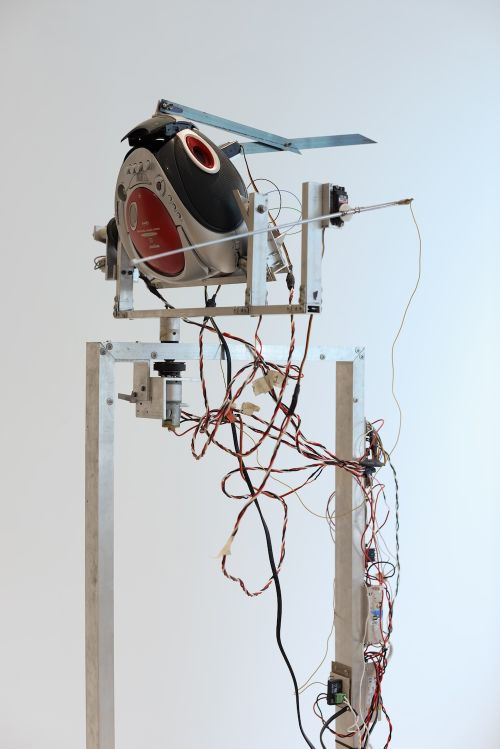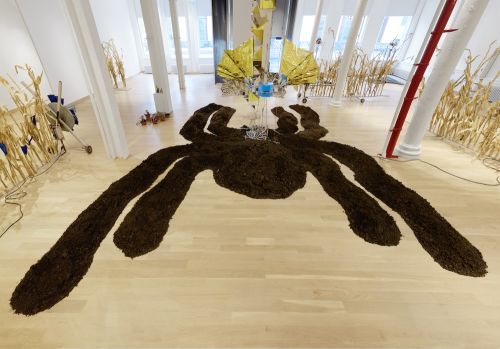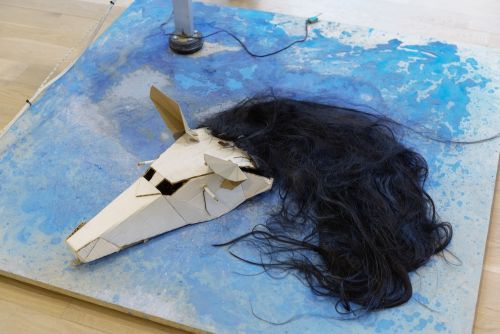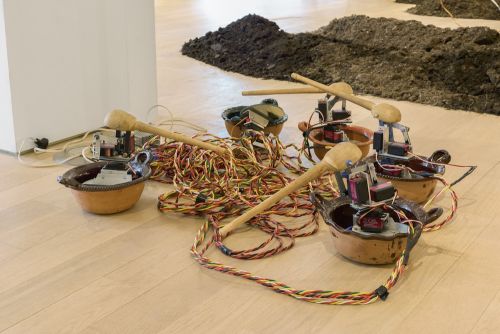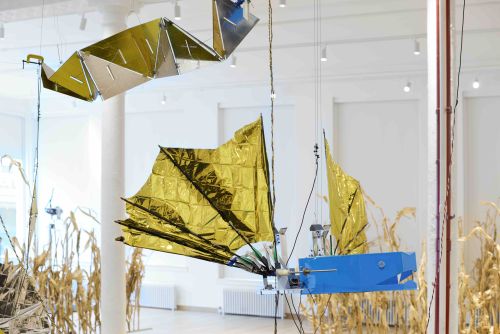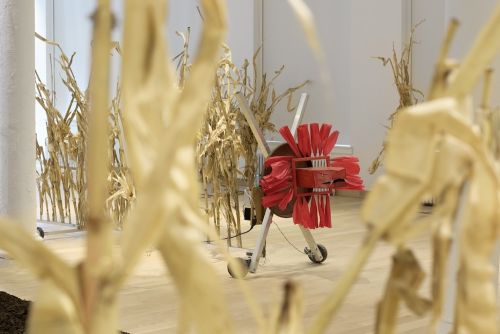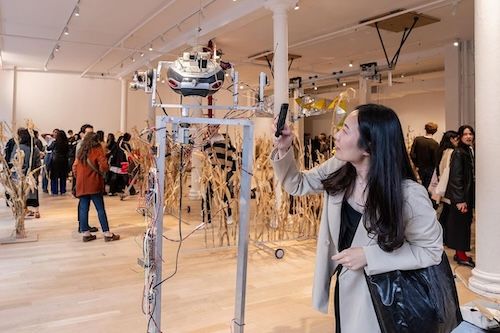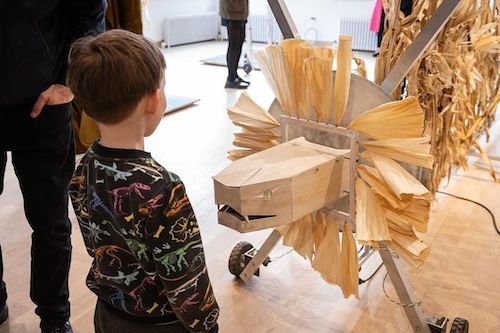Fernando Palma Rodríguez: ĀMANTẼCAYÕTL
May 3–July 27, 2024Opening, May 3, 2024, 6-8pm
Āmantēcayōtl: And When it Disappears, it is Said, the Moon has Died, celebrates Fernando Palma Rodríguez’s pioneering robotic work by presenting a newly commissioned installation that speaks to the origin of corn. The installation emulates a corn field, traditionally known as a Milpa, on the slopes of the Teuhtli Volcano. Alongside the Milpa, we encounter robotic entities that represent deities of the Mesoamerican pantheon. Combining his training as an artist and mechanical engineer, Palma Rodríguez’s practice responds to the effects of industrialization in his native territory while also proposing a definition of technology as one determined by people’s capacity to cultivate life.
Āmantēcayōtl: Auh inihcuac huel ompoliuh, mitoa, ommic in meztli, is the materialization of the entangled relationship that exists between cosmology, technology, and land. At the center of the exhibition, the Cincoatl snake glides above the Milpa –a millenarian crop where corn, beans, and squash are harvested together. Throughout time, farmers have encouraged the Cincoatl snake to roam their crops. The name Cincoatl is often translated as “snake-friend of maize corn.” In ancient codices and across Mesoamerican iconographies, the snake has been associated with a vision of the underworld. However, in this exhibition, it is presented as coming from above, for it is also known to be a transgressor between earth and sky. Besides its multiple significations, Palma Rodríguez identifies the snake’s synodal-wave shape as an expression of the creature’s inherent electromagnetic force. He explains, “when one understands that the snake is a network of energy, we know that what we are talking about is the earth, because the earth is clothed in energy. A tree is energy, the sky is energy, the sun is energy, and consequently, we are all an energetic sea.”
Surrounding the Cincoatl are four Chinantles, each representing the cardinal directions signified by the colors white, red, blue, and black. The Chinantles are traditional barriers made of corn stalks. Like the Cincoatl snake, the Chinantles are an avatar of the Aztec Quetzalcoatl, which is commonly known as the Feathered Serpent; a deity related to wind, Venus, the Sun, arts, knowledge, and learning. As the Chinantles slide through the four cardinal directions, they delineate the sacred place of the Milpa harvest.
To the side of Cincoatl, stand two Tezcatlipocas. They represent the god of the Great Bear Constellation and the night sky. Tezcatlipoca is a prolific shapeshifter and trickster, who commonly appears as a large jaguar, also referred to as “Heart of the Mountain.” The historian Guilhem Oliver explains that Tezcatlipoca is associated with dance, music, and the origin of corn, all of which appear in different accounts of the figure across Mesoamerican cultures. According to one myth, Tezcatlipoca takes on the body of a coyote and in the middle of a sacred field called Paxil, lets out a loud laughter. The outburst was so loud that it caused Tezcatlipoca to explode, revealing from his entrails the presence of corn and with it, his nature as a corn-being. The outburst ultimately was deemed as having the capacity to announce people’s destiny through maize; that is, the origin of the Mesoamerican people and their main source of nourishment.
The discovery of corn and its value in Aztec communities yields also the beginning of the millenarian Milpa. In the Milpa, three plants are grown together: maize, bean, and squash. Each plant benefits the other. Beans fix nitrogen, essential to the healthy growth of maize plants. In turn, maize stalks grow taller providing a scaffold upon which the bean plant climbs up, encouraging the blossoming of flowers that aid bean pollination. The large squash leaves grow abundantly covering large areas in shadow so that no weeds can grow underneath. These Milpa’s reciprocity and interdependence are in turn the principles that define the notion of Indigenous Technologies.
Chilean sociologist Luis Razeto Migliaro advanced a relevant definition of Indigenous technologies, which he describes as the capacity to cultivate life. Indigenous technologies, he argues, are the result of “saber criar la vida y dejarse criar por la vida,” which loosely translates to, knowing how to cultivate life and letting life cultivate you. Following this notion, Palma Rodríguez’s robots, Tezatipotla, Cincoatl, and the Chinantles, center on ancestral knowledges, practices, and worldviews as orientations that are responsible for yielding livable worlds. Despite their many associations, these cyborgs are, however, not mere instruments of representation, but the embodiment of world-making practices that transform the utility of the machine into a web of human and non-human relationalities.
Curated by Sara Garzón.
Special thanks to the artist Fernando Palma Rodríguez, the engineer Edgar Espinoza, and House of Gaga, especially Gabriela Magaña for their support.
Fernando Palma Rodríguez (Mexican, b. 1957) lives in the agricultural region of Milpa Alta outside Mexico City, where he runs Calpulli Tecalco, a non-profit organization dedicated to the preservation of Nahua language and culture. Central to Palma Rodríguez’s practice is an emphasis on indigenous ancestral knowledge, both as an integral part of contemporary life and a way of shaping the future. Fernando Palma Rodríguez lives and works in San Pedro Atocpan, Mexico. He was the subject of a retrospective at Museo de Arte Contemporáneo de Oaxaca (2017). His work has been included in group exhibitions at FRAC des Pays de la Loire, Carquefou, France (2016); Parallel Oaxaca, Mexico (2016); Nottingham Contemporary, England (2015); the Biennial of the Americas, Denver, Colorado (2015); Museo Universitario del Chopo, Mexico City, Mexico (2014); and SITE Santa Fe, New Mexico (2014). Also, there was an exhibition of his work at MoMA in NYC called In Ixtli in Yollotl, We the People (2018).
